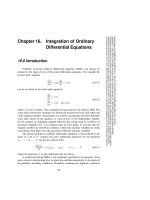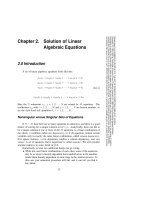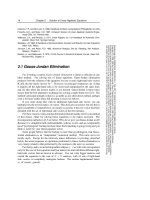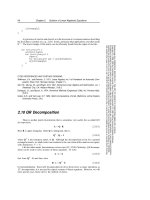Tài liệu Safety Of Life At Sea - Part 2 pptx
Bạn đang xem bản rút gọn của tài liệu. Xem và tải ngay bản đầy đủ của tài liệu tại đây (229.26 KB, 12 trang )
2-1
Safety
Of
Life
At
Sea
2-2
Chapter I - General Provisions
Includes regulations concerning the survey
of the various types of ships and the
issuing of documents signifying that the
ship meets the requirements of the
Convention.
The Chapter also includes provisions for
the control of ships in ports of other
Contracting Governments.
2-3
Chapter II-1 - Construction -
Subdivision and stability, machinery and
electrical installations
The subdivision of passenger ships into watertight
compartments must be such that after assumed
damage to the ship's hull the vessel will remain
afloat and stable.
Requirements for watertight integrity and bilge
pumping arrangements for passenger ships are
also laid down as well as stability requirements for
both passenger and cargo ships.
2-4
Chapter II-1 - Construction -
Subdivision and stability, machinery and
electrical installations
The degree of subdivision - measured by
the maximum permissible distance
between two adjacent bulkheads - varies
with ship's length and the service in which
it is engaged.
The highest degree of subdivision applies
to passenger ships.
2-5
Chapter II-1 - Construction -
Subdivision and stability, machinery and
electrical installations
Requirements covering machinery and
electrical installations are designed to
ensure that services which are essential for
the safety of the ship, passengers and
crew are maintained under various
emergency conditions.
The steering gear requirements of this
Chapter are particularly important.
2-6
Chapter II-2 - Fire protection, fire
detection and fire extinction
Includes detailed fire safety provisions for
all ships and specific measures for
passenger ships, cargo ships and tankers.
They include the following principles:
division of the ship into main and vertical
zones by thermal and structural
boundaries; separation of accommodation
spaces from the remainder of the ship by
thermal and structural boundaries;
2-7
Chapter II-2 - Fire protection, fire
detection and fire extinction
restricted use of combustible materials;
detection of any fire in the zone of origin;
containment and extinction of any fire in
the space of origin; protection of the
means of escape or of access for fire-
fighting purposes; ready availability of fire-
extinguishing appliances; minimization of
the possibility of ignition of flammable
cargo vapour.
2-8
Chapter II-2 - Fire protection, fire
detection and fire extinction
A new revised chapter II-2 was adopted in
December 2000, entering into force on 1
July 2002.
2-9
Chapter III - Life-saving appliances and
arrangements
A revised Chapter was adopted in 1996
and entered into force on 1 July 1998. The
revisions took into account changes in
technology since the Chapter was last
revised in 1983.
2-10
Chapter III - Life-saving appliances and
arrangements
Under the 1996 revision, specific technical
requirements were moved to a new
International Life-Saving Appliance (LSA)
Code, made mandatory under Regulation
34, which states that all life-saving
appliances and arrangements shall comply
with the applicable requirements of the
LSA Code.
2-11
Chapter III - Life-saving appliances and
arrangements
The Chapter entered into force on 1 July
1998 and applies to all ships built on or
after 1 July 1998, with some new
amendments to the previous Chapter also
applying to ships built before that date.
2-12
Chapter III - Life-saving appliances and
arrangements
The text of the 1996 Chapter takes into
account technological changes, such as the
development of marine evacuation
systems: these systems involve the use of
slides, similar to those installed on aircraft.
2-13
Chapter III - Life-saving appliances and
arrangements
The 1996 revision of Chapter III also reflects
public concern over safety issues, raised by a
series of major accidents in the 1980s and 1990s.
Many of the passenger ship regulations have been
made applicable to existing ships, and extra
regulations were introduced specifically for ro-ro
passenger ships.
2-14
Chapter IV - Radiocommunications
The Chapter was completely revised in
1988 to incorporate amendments to
introduce the Global Maritime Distress and
Safety System (GMDSS).
2-15
Chapter IV - Radiocommunications
The amendments entered into force on 1
February 1992 with a phase-in period to 1
February 1999.
By that date the Morse Code was phased
out and all passenger ships and all cargo
ships of 300 gross tonnage and upwards
on international voyages are now required
to carry equipment designed to improve
the chances of rescue following an
accident,
2-16
Chapter IV - Radiocommunications
including satellite emergency position
indicating radio beacons (EPIRBs) and
search and rescue transponders (SARTs)
for the location of the ship or survival
craft.
Chapter IV of SOLAS was previously titled
Radiotelegraphy and radiotelephony,
reflecting the forms of radio
communication available prior to the
introduction of satellites.
2-17
Chapter IV - Radiocommunications
Regulations in Chapter IV cover
undertakings by contracting governments
to provide radiocommunciation services as
well as ship requirements for carriage of
radiocommunications equipment.
The Chapter is closely linked to the Radio
Regulations of the International
Telecommunication Union.
2-18
Chapter V - Safety of navigation
Chapter V identifies certain navigation
safety services which should be provided
by Contracting Governments and sets forth
provisions of an operational nature
applicable in general to all ships on all
voyages.
This is in contrast to the Convention as a
whole, which only applies to certain classes
of ship engaged on international voyages.
2-19
Chapter V - Safety of navigation
The subjects covered include the
maintenance of meteorological services for
ships; the ice patrol service; routeing of
ships; and the maintenance of search and
rescue services.
2-20
Chapter V - Safety of navigation
This Chapter also includes a general
obligation for masters to proceed to the
assistance of those in distress and for
Contracting Governments to ensure that all
ships shall be sufficiently and efficiently
manned from a safety point of view.
2-21
Chapter V - Safety of navigation
A new revised chapter V was adopted in
December 2000, entering into force on 1
July 2002. The new chapter makes
mandatory the carriage of voyage data
recorders (VDRs) and automatic ship
identification systems (AIS) for certain
ships.
2-22
Any Questions?
2-23
Thank you









